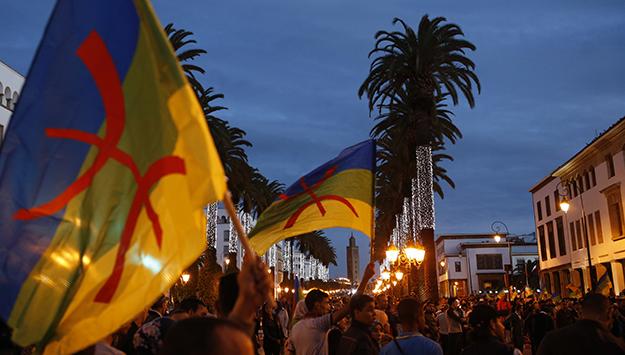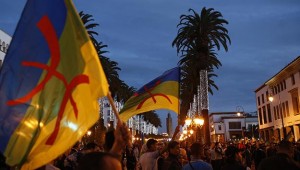Middle East Institute
By Samia Errazzouki
Screams and gruesome images mar the graphic video of a young man being crushed to death in the back of a garbage truck. Late Friday night, October 28, Mouhcine Fikri, a fish vendor from the northern town of Imzouren, desperately tried to retrieve his 500 kgs of swordfish, which authorities threw away because of a fisheries law that bans the fishing of swordfish during this time of year.
The incident unfolded in the coastal city of Hoceima, located in the historically socioeconomically marginalized Rif region. Within hours, videos and images began circulating throughout social media with the hashtag “T’han mo,” or “Grind him”—words that a local security official reportedly proclaimed to the operator of the garbage truck as Fikri leapt inside; allegations authorities have denied. Nevertheless, in less than 48 hours, protests were taking place throughout Morocco denouncing Fikri’s gruesome death and have been ongoing for over a week. In a swift response, King Mohammed VI gave specific instructions to the interior minister, Mohammed Hassad, to visit Fikri’s family and ensure a thorough investigation. Just a few days later, on November 1, 11 individuals, including security agents and local fisheries officials, were charged with manslaughter.
For the Moroccan regime, the stakes were high. If the timeline seems condensed, that is no coincidence. Swiftly quelling dissent surrounding Fikri’s death was paramount for several reasons. Firstly, the country was in the midst of hosting the 22nd annual United Nations Climate Change Conference (the Conference of Parties, or commonly known as COP22), where leaders from throughout the world will gather in Marrakech. Secondly, Prime Minister Abdelilah Benkirane from the Party of Justice and Development—which was just recently elected early October for a second mandate—is still negotiating to form a coalition government with other political parties. And thirdly, Morocco is actively pushing forth an image of national unity as it continues to make its case to the international community about its claims on Western Sahara. In sum, Mouhcine Fikri’s death is the biggest test to the Moroccan regime since the rise of the February 20th Movement in 2011—the country’s mild adaptation of the “Arab Spring.”
To better understand the political significance of Fikri’s death, it is imperative to situate the relationship between the Rif region, where Fikri is from, and the central authority of the Moroccan regime. Even before Morocco gained its independence in 1956, the northern, mountainous, and predominantly ethnically Amazigh Rif region followed a different rhythm than the rest of the country. When the Spanish began laying down the groundwork for their colonization of northern Morocco in the early 1900s, the Rif region was quick to mobilize and take up arms under the leadership of Abdelkrim al-Khattabi. It was under his tenure that the Rif briefly set up its own republic, complete with its own flag and currency. That came to a swift end in the mid-1920s when the French and Spanish pummeled the region with what many historians concluded were German-made chemical weapons, resulting in an estimated 10,000 dead. This all took place under the passive approval of the Moroccan sultan, who too had an interest in dissolving any semblance of an independent Rif region for the sake of maintaining a more territorially complete Morocco should the day of independence come.
When that day did arrive in 1956, the Moroccan regime found the Rif region beyond the grasp of its power and control, inciting a revolt in 1958 that gave way for martial law under the leadership of then crown prince Hassan II. The contentious relationship with the Rif continued under Hassan II’s reign as king, who referred to its inhabitants as “savages” during a notorious speech in the 1980s. Throughout the 1990s and up until only recently, the Rif was one of the most socioeconomically marginalized regions in Morocco, deprived of even the most basic infrastructure, forcing many of the region’s inhabitants to migrate abroad, while many locals began cultivating the region’s lucrative hash industry. Today, the Rif region is among the poorest in Morocco, with rates ranging between 17 and 34 percent in certain areas; much higher than the national average of 13 percent.
Mouhcine Fikri’s horrific death in the Rifian town of Hoceima fits into a broader history that many in the Rif have described as the manifestation of hogra, or the deprivation of dignity. It was only five years ago that the charred bodies of five youth in Hoceima were found in a bank during the eve of the February 20th Movement, which served as a catalyst for a nationwide movement that lasted over a year. This is not to say that Hoceima is the only city where hogra exists in Morocco. Countless of cases reflect hogra in Morocco: the self-immolation of single mother Fadoua Laroui in 2011 Souk Sebt; the suicide of Amina Filali, forced to marry her rapist, in Larache in 2012; the self-immolation of Mi Fatiha in Kentira earlier this year, among others.
But why is it that Fikri’s death, in specific, has sparked such widespread outrage, carrying the waves of hogra along with it? It is arguably the gruesome manner in which he died, which so aptly illustrates hogra. Authorities seizing his merchandise, standing aside as his merchandise is thrown away in a garbage truck, watching as he is crushed to death among heaps of garbage, hopelessly trying to salvage what little source of income he and his family have to rely on.
Furthermore, this incident was witnessed by dozens in person, and filmed, then later widely shared on social media, giving the Fikri’s gruesome death greater amplification. It was not long before locals began drawing parallels with the strife of Mohammed Bouazizi, leading many to believe that perhaps this might be Morocco’s belated “moment.”
With the king immediately intervening in the case of Mouhcine Fikri, demanding a “thorough” investigation, it cooled the flames, buying the authorities time, and demonstrating that the cries of the people have been heard to the highest echelons of Moroccan power. Nevertheless the king’s intervention indirectly implies the inefficiency of the justice system, suggesting that if it were not for his involvement, the case would have not progressed. It has already been over a week since Fikri’s death, and while protests continue, momentum has begun to dwindle as measured by the declining number of participants during protests. Additionally, those protesting have been mobilizing on a weekly basis, rather than daily, contributing to the slowed momentum.
This, paired with the king’s immediate response by intervening in Fikri’s case, in many ways parallels the timeline of the February 20th Movement in 2011. Similarly, the movement began in big numbers, protesting weekly rather than daily, followed by a major speech delivered by the king just three weeks after the movement’s first protests. Months later, the movement dwindled in numbers and the Moroccan regime carried on unscathed, but with minor reforms and a newly elected government.
Fikri’s death may, thus, not prove to be Morocco’s revolutionary moment, but could set a precedent whereby the average Moroccan no longer accepts hogra as the norm, and individuals with the state are held accountable for their actions. What is certain, however, is the normalization of the demand for what has become the universal slogan in protests for the past week: “Freedom, dignity, and social justice.” This underlying sentiment will not be disappearing anytime soon.








